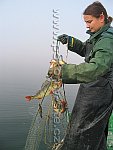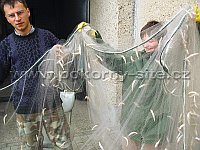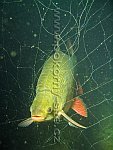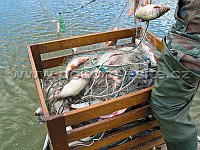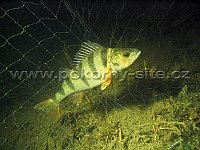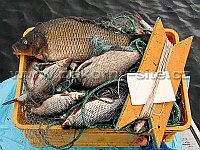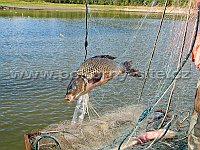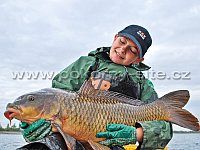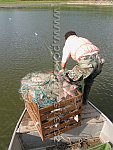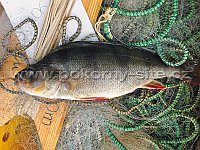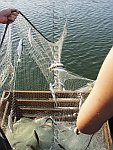Fishing nets - Passive fishing gear
Profile
display / hide whole profile
RNDr. Marie Prchalová, Ph.D.
 I work at the Institute of Hydrobiology (Biology Centre AS CR, v.v.i., Fish Ecology Unit). My research focuses on fish ecology in reservoirs, especially fish spatial distribution. In addition, I also work on gillnet sampling methodology of fish communities. I am an active contributor to the development of standardized sampling and evaluation techniques for fish communities for the European Water Framework Directive and I assist in updating the European Standard EN 14757 (“Water quality – sampling of fish with multimesh gillnets”). In the past, I have participated in the Spanish Ministry of Environment’s project on the calibration of sampling methods in Spanish reservoirs. I also contributed to projects of tropical fish ecology in reservoirs of Thailand, the Philippines, Sri Lanka and Puerto Rico, and was involved in fish community research in Dutch reservoirs, which was financed by the Dutch drinking water company.
I work at the Institute of Hydrobiology (Biology Centre AS CR, v.v.i., Fish Ecology Unit). My research focuses on fish ecology in reservoirs, especially fish spatial distribution. In addition, I also work on gillnet sampling methodology of fish communities. I am an active contributor to the development of standardized sampling and evaluation techniques for fish communities for the European Water Framework Directive and I assist in updating the European Standard EN 14757 (“Water quality – sampling of fish with multimesh gillnets”). In the past, I have participated in the Spanish Ministry of Environment’s project on the calibration of sampling methods in Spanish reservoirs. I also contributed to projects of tropical fish ecology in reservoirs of Thailand, the Philippines, Sri Lanka and Puerto Rico, and was involved in fish community research in Dutch reservoirs, which was financed by the Dutch drinking water company.
In my work I analyze gillnet sampling methodology of fish communities and am an internationally respected and cited author. I am also involved in reviewing scientific manuscripts prior to their acceptance to journals. I was the principal researcher of two projects which dealt with gillnet methodology. Together with my colleagues, I have published many scientific articles on gillnet sampling of fish communities. For example, we examined the underestimation of small fish and overestimation of large fish in gillnet catches (Prchalová et al., 2008 and 2009). Gillnet catches were also used to describe fish activity in detail (Vašek et al. 2009, Prchalová et al. 2010). A model of gillnet sampling was developed and we suggested a new way to express gillnet catches. This model avoids the influence of changes in fish activity, fish falling out of gillnets during exposure and saturation of gillnets (Prchalová et al. 2011 and 2013). In Prchalová et al. 2012, the advantages and disadvantages of catching small tropical fish Dorosoma petenense into gillnets and trawls are discussed. Gillnets were also used in research estimating the abundance of fish in the blind zone of a hydroacustic survey (Tušer et al. 2013). Based on sections of the entangled gillnet where the eel attacked fish caught in gillnets, I described the estimation of the European eel (Prchalová et al. 2013). Recently my work entails appropriate gillnet sampling design, with the calibration of gillnet catches according to known fish communities and with differences in gender-dependent gillnet catchability of several fish species. All my research is based on using gillnets made by the Pokorný-sítě company. We collaborate in development of the new gillnet types or in innovation of the sampling design.
Kontakt: marie.prchalova@hbu.cas.cz
http://www.fishecu.cz/staff-members/prchalova/
References:
Prchalová, M., Kubečka, J., Říha, M., Čech, M., Jůza, T., Ketelaars, H.A.M., Kratochvíl, M., Mrkvička, T., Peterka, J., Vašek, M., Wagenvoort, A.J., 2013. Eel attacks - A new tool for assessing European eel (Anguilla anguilla) abundance and distribution patterns with gillnet sampling. Limnologica 43, 194-202.
Prchalová, M., Peterka, J., Čech, M., Kubečka, J., 2013. A simple proof of gillnet saturation. Boreal Environment Research 18, 303-308.
Tušer, M., Prchalová, M., Mrkvička, T., Frouzová, J., Čech, M., Peterka, J., Jůza, T., Vašek, M., Kratochvíl, M., Draštík, V., Kubečka, J., 2013. A simple method to correct the results of acoustic surveys for fish hidden in the dead zone. Journal of Applied Ichthyology 29, 358-363.
Prchalová, M., Neal, J. W., Munoz-Hincapié M., Jůza, T., Říha, M., Kubečka, J., 2012. Comparison of gillnets versus fixed-frame trawl for sampling threadfin shad in tropical reservoirs. Transactions of the American Fisheries Society 141, 1151-1160.
Prchalová, M., Mrkvička, T., Peterka, J., Čech, M., Berec, L., Kubečka, J., 2011. A model of gillnet catch in relation to the catchable biomass, saturation and soak time. Fisheries Research 107, 201-209.
Prchalová, M., Mrkvička, T., Kubečka, J., Peterka, J., Čech, M., Muška, M., Kratochvíl, M., Vašek, M., 2010. Fish activity as determined by gillnet catch: A comparison of two reservoirs of different turbidity. Fisheries Research 102, 291-296.
Prchalová, M., Kubečka, J., Říha, M., Mrkvička, T., Vašek, M., Jůza, T., Kratochvíl, M., Peterka, J., Draštík, V., Křížek, J., 2009. Size selectivity of standardized multimesh gillnets in sampling coarse European species. Fisheries Research 96, 51-57.
Vašek, M., Kubečka, J., Čech, M., Draštík, V., Matěna, J., Mrkvička, T., Peterka, J., Prchalová, M., 2009. Diel variation in gillnet catches and vertical distribution of pelagic fishes in a stratified European reservoir. Fisheries Research 96, 64-69.
Prchalová, M., Kubečka, J., Říha, M., Litvín, R., Čech, M., Frouzová, J., Hladík, M., Hohausová, E., Peterka, J., Vašek, M., 2008. Overestimation of percid fishes in gillnet sampling. Fisheries Research 91/1, 79-87.
Gillnets
What was enmeshed in gillnet is likely to become a filet.
- gillnets are used to catch fishes in both freshwater and marine environments
- gillnets belong to the group of passive fishing gear
- the catch success is fully dependent on fish activity
- gillnets create a wall of netting, in which the fish is enmeshed
The advantages of gillnets:
- The possibility of fishing in all available depths
- The possibility of fishing on any slope of the bottom
- The possibility of fishing in almost all habitats – in lake/ reservoir
- The spectrum of catchable fish is very broad (unlimited)
- Fish of all sizes can be caught in gillnets
- Due to the geometric series of mesh sizes, fish across the length-frequency distribution are able to be caught
- Samples caught in gillnets serve as the basis for determining the length-frequency and age–frequency distribution of a population
- Our gillnets fulfil the requirements of Water Framework Directive
These advantages make gillnets one of most used nets for the fish community research
- The importance of gillnets as a sampling tool is emphasized by the European Standard Document (EN 14 757 Water quality – Sampling of fish with multimesh gillnets, revision 2014)
- The European Norm was approved as the Czech National Norm ČSN EN 14757 Water quality – Sampling of fish with multimesh gillnets (revision 2015)
- The Norm describes the methodology of fish stock assessment in terms of species occurrence, size composition, quantitative relative abundance and biomass expressed to unit of effort (Catch Per Unit of Effort, CPUE) of a fish community in lentic waters of the temperate region. This Document further contains a design of gillnets together with the summary of mesh sizes and their thread diameters.
The exceptional standing of gillnet data in Europe
In our contemporary and globalized world, the crucial issue is the use of a singular method which enables data comparison among countries. The European Committee for Standardization (CEN), consisting of experts from 33 European countries, is the most important such organization in the European sphere. The norms produced by CEN are accepted by individual member countries as national norms. The most important document in the field of fish sampling is the norm CEN14962 “Water quality — Guidance on the scope and selection of fish sampling methods”, which also exist in Czech as ČSN EN 14962 (757710) Water quality — Guidance on the scope and selection of fish sampling methods . The norm describes the process to choose the appropriate evaluation method for fish communities in rivers, lakes and brackish waters. Each method is also briefly described and the recommendation for each ecosystem is included in the norm. For example, with respect to the goal of monitoring, sampling by beach seining is recommended for use in inshore areas of lotic fresh waters, while trawling, drifting gillnets or traps are the recommended sampling method for offshore areas. In lentic waters beach seining is recommended for sampling inshore areas, while offshore areas
should be sampled with traps, and in the case of large, deep water bodies purse seining and trawling can be used. Nets have a broad range of applications with which no other sampling method can compare.
Gillnets as the main sampling method
Currently the most important legislative document in the field of EU water policy is the Water Framework Directive (2000/60/ES). This document instructs member countries to develop a national methodology to evaluate the ecological state of natural water bodies and the ecological potential of strongly modified and man-made water bodies. In the Czech Republic, the methodology for evaluating the biological components of fish in reservoirs and artificial lakes was based on the data obtained from gillnet samples (Borovec et al. 2014). The next step is the process of inter-calibration where member countries are grouped according to their geographic region to compare and discuss the various methodologies. The Czech Republic belongs to the Central and Baltic region (C/B GIG). Experts from other countries in the region use gillnet sampling to obtain information about fish communities. Concurrently, the gillnet sampling is standardized by European Norm CEN 14757 Water quality - Sampling of fish with multi-mesh gillnets (Czech version ČSN EN 14757).
Europe-wide attempts to unify the evaluation of fish communities into the WISER project (www.wiser.eu) resulted in the formation of the Europe-wide database of fish catches (Causeé et al. 2011). The data characterizing lakes include exclusively gillnet catches, which in the case of the Czech Republic were made by the Pokorný – Sítě company. The first results were based on benthic gillnet catches solely from natural lakes (e.g. Argillier et al. 2013, Brucet et al. 2013). Further research will also focus on artificial lakes and on the sampling of pelagic fish communities.
References:
Innovations of scientists from the Institute of Hydrobiology BC AS CR, v.v.i. in České Budějovice
- extend the standard gillnet series (12 mesh sizes) by an additional 4 mesh sizes
- the additional mesh sizes are 70, 90, 110 and 135 mm
- large meshes are suitable for large specimens of carp, pikeperch, bream, rudd, tench, pike, catfish etc. (above 35 cm of length)
- mesh sizes follow the geometric series using a factor of 1.25
Design:
- large mesh gillnets are installed as a separate gillnet
- total length of the buoyancy line is 40 m
- total length of the lead line is 48 m
- the length of each mesh panel is 10 m in the gillnet
- the height, the type and design is in accordance to the basic types of gillnets
- benthic gillnets has height of 1.5 m
- pelagic gillnets has height of 3 m, 4.5 m or 6 m
Innovations in the deployment of gillnets:
- Sampling in order to obtain many independent samples
- Three or four gillnets are joined together to create a gillnet set
- Joining gillnets into sets with a long rope (usually 30 m) is more efficient than installing single gillnets
Description of innovations:
Descriptions of the innovations are included in the book about the methodology of monitoring fish communities in lakes and reservoirs (publisher Institute of Hydrobiology, BC AS CR, v.v.i., collective authorship J. Kubečka, J. Frouzová, T. Jůza, M. Kratochvíl, M. Prchalová, M. Říha, 64 pp., in Czech), which also includes descriptions about trawling, beach seining, electrofishing and hydroacoustic methodology.
The table shows the mesh order mesh size and thread diameter in gillnets according to Norm EN 14 757
| The mesh order in gillnet | The mesh size in mm | Thread diameter |
|---|---|---|
| 10 | 5 | 0.10 |
| 3 | 6.25 | 0.10 |
| 6 | 8 | 0.10 |
| 4 | 10 | 0.12 |
| 7 | 12.5 | 0.12 |
| 9 | 15.5 | 0.15 |
| 2 | 19.5 | 0.15 |
| 8 | 24 | 0.17 |
| 12 | 29 | 0.17 |
| 11 | 35 | 0.20 |
| 1 | 43 | 0.20 |
| 5 | 55 | 0.25 |
Table shows the mesh order, the mesh size and thread diameter in large mesh gillnets according to innovations of scientists from the Institute of Hydrobiology BC AS CR, v.v.i. in České Budějovice
| The mesh order in gillnet | The mesh size in mm | Thread diameter |
|---|---|---|
| 3 | 70 | 0.25 |
| 1 | 90 | 0.25 |
| 4 | 110 | 4x0.15 |
| 2 | 135 | 6x0.20 |
The size characteristics of 12-mesh gillnet:
- buoyancy line 30 m
- lead line 36 m
The sizes and shape of the gillnet
- the European Standard gillnet consists of 12 different mesh size panels
- each panel has trapezoid shape
- the length of each panel’s buoyancy line is 2.5 m
- the length of each panel’s lead line is 3 m
- the panel lengths are equal in all types of gillnet
Gillnet height
- the gillnet is longitudinally subdivided into 1.5 m high strips by row of differentiated meshes
- the maximum gillnet height is 6 m
- the benthic gillnets are 1.5 m in height
- the pelagic gillnets are made in heights of 1.5, 3, 4.5 and 6 m
The size characteristics of 4-mesh gillnet:
- buoyancy line 40 m
- lead line 48 m
Two basic gillnet types are available – benthic and pelagic
The benthic gillnets
- sinking gillnets – they do not float
- deployment on the bottom of the water body
- deployment without stretching the net
- anchorage is not needed
- height 1.5 m, length 30 m
- it is possible to attach several gillnets to make a set
- coupling line is usually 30 m long
- coupling line is sinking
The pelagic gillnets
- three types of the pelagic gillnets are distinguished – epipelagic, mesopelagic and bathypelagic
The epipelagic gillnets – fully floating
- floating gillnets
- they are deployed on the surface
- It is recommended to anchor them from both ends
- the length is 30 m with possible heights of 1.5, 3, 4.5 and 6 m
- it is possible to attach several gillnets to make a set
- coupling line is usually 30 m long
- coupling line is floating
The mesopelagic gillnets
- slowly sinking gillnet – may be deployed from water surface to any arbitrary depth
- the depth is regulated by a line between float and buoyancy line
- deployment takes place on the water surface and the gillnet sinks to the targeted depth
- it is recommended to anchor from both ends of the gillnet
- the length is 30 m with possible heights of 1.5, 3, 4.5 and 6 m
- it is possible to attach several gillnets to make a set
- coupling line is usually 30 m long
- coupling line is sinking
The bathypelagic gillnets
- floating gillnets that may be deployed from the bottom to any arbitrary depth
- the deployment depth is regulated by a line from the anchor and the lead line
- bathypelagic gillnets are being anchored to the bottom
- using two floats at both ends of the gillnet is recommended
- the length is 30 m with possible heights of 1.5, 3, 4.5 and 6 m
- creating set of several gillnets is possible
- coupling line is usually 30 m long
- coupling line is sinking
Placement of the gillnet in the water column
Placement of benthic and bathypelagic gillnets in lake and reservoir habitats
Gillnet finder
Keep in mind the following ethical standards:
- a gillnet lost at depths is still fishing
- never leave a lost gillnet in the water
- use our gillnet fi nder for fi nding and lifting lost gillnet
Usage:
- finding lost nets
- gillnets, fish traps etc.
Advantages:
- special shape preventing gillnet finder from getting stuck
- easy to get the gillnet fi nder free
- easy to store and use
Composition:
- three arm anchor made from steel poles of 12 mm in diameter
- hauling cord – white, 30 m
- extrication cord – red with float – 20 m
Size:
- height: 45 cm
- length of the arm: 20 cm
- diameter 12 mm
Instructions for use:
- sink the gillnet fi nder into the water in the area where the gillnet was lost
- extrication cord must be attached to the crossbar of the anchor arm
- extrication cord must be suffi ciently long
- extrication cord must be 1.5 times longer than the maximum depth
- float must be attached to the extrication cord
- haul the gillnet fi nder on the bottom
- haul the gillnet fi nder either by hand or by boat
- use a row boat for finding gillnet, not a motor boat
- the haul should be slow and steady
- after the gillnet fi nder entangles the net, draw it out of water
- haul the gillnet fi nder through an appropriately spaced grid of the area where you expect to fi nd the gillnet
- when the shore steepness is larger than 5°, haul the gillnet fi nder perpendicularly to the shore
Instrucitons to extricate stucked gillnet finder:
- attach the fl oat to the hauling cord and throw into the water
- drive the ship on the opposite side of the haul
- grab the fl oat with the extrication cord
- fully stretch the extrication cord
- give the cord strong tugs until the gillnet finder is released
- drive with the boat to the side and pull strongly the extrication cord until the gillnet finder is released
use of pelagic and benthic 12 mesh size gillnets (for mesh sizes see table above, length 12 x 2.5 m, height 1.5 - 4.5 m)
